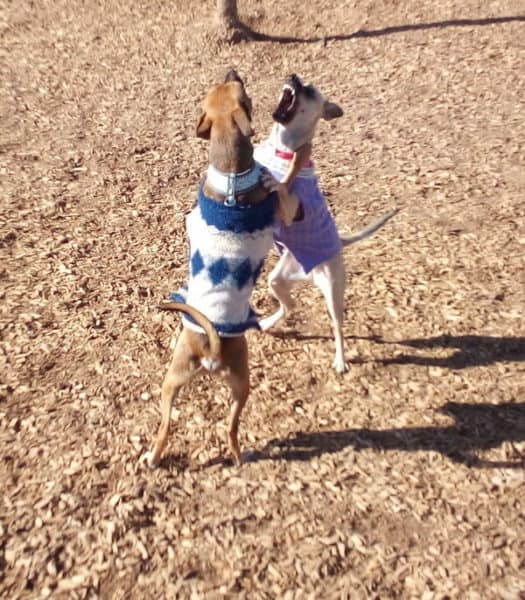Many dog trainers look to throw together a short and attractive sound-bite, then come up with a bunch of reasons why this is both so different and such a terrific approach. Since many people have heard that packs are so very natural, why not just make that the name?
Pack Dynamic Training
Pack Dynamic Training is our preferred All-Natural Behavior Training Methodology
Every day we learn how to better utilize our own exclusive, force-free, all-natural Pack Dynamic Training process to help dogs and owners in need.
Working with scientifically safe and proven Classical & Operant Conditioning processes and exercises while expertly harnessing the all-natural effects and benefits of Allelomimetic Behavior & Social Facilitation, we have the ability to help dogs and their owners in a way that simply isn’t found anywhere else.
Canine Behavioral Services INC
Oh, my! It’s rather difficult to know just where to start on this one! So how about that pack dynamic?
Pack Learning
Allelomimetic behavior or allomimetic behavior is a range of activities in which the performance of a behavior increases the probability of that behavior being performed by other nearby animals.
It is usually considered to occur between members of the same species.
Wikipedia
If this has, as they say, a large natural component, than it would occur nearly every time you had a large group of dogs meeting and doing things. And if that were the case, how can they say this is their own exclusive method?

As for something natural being force-free, have they never seen very young pups being trained by an experienced mother dog? Or rambunctious teenage dogs being corrected by adults? No matter if this is about dogs or any other animal you might wish to choose, I suggest there is nothing force-free about this.
Also, many people who volunteer at dog shelters have seen the staff take a loud and jumping dog and move them next to a quiet and peaceful one, in the false hope that he will learn peace from the other. Something which almost never works, so why would this here?
Now, what if one dog is, say, digging in the corner of his kennel until he can crawl out and run free? In that case some others (but not all) may pick up on that. However, in teaching behaviors such as social skills, just watching another dog simply doesn’t give nearly as much information as the dog actually trying it themselves.
So, there are certainly some benefits here, and this is certainly natural. However, there’s nothing exclusive and it’s surely not force-free.
Proven Safe
Their claim of operant conditioning being scientifically safe and proven is just plain silly. While gravity has been scientifically proven, falling down over a distance is anything but safe. And that’s even before we look at the different forms listed under operant conditioning, which includes such things as positive punishment (i.e. add noxious stimulus following behavior).
Let’s say that every time this dog jumps on me I just freeze and stare at him, until he goes down. Or, instead I hit him on the head with a bat so that he falls away. While both of them are the same form of operant conditioning, one is somewhat safer than the other, at least from the dog’s perspective.
The Well-Balanced Argument
Through consistent positive canine social interactions with our confident & experienced Pack Dogs, other imbalanced dogs learn how to feel better about themselves and how to exhibit more socially-acceptable behaviors.
Let’s start here by just throwing out their imbalanced dogs. Unless that dog walks with a severe limp and occasionally falls over, there just isn’t any such thing.

It’s taken many years of hard work to get here but we are uniquely qualified to help dogs in ways that others can’t, treating behaviors and issues successfully, where others have failed.
There’s no hint of what they had been doing previously for all those long years, or why it took them this long! As for their being unique, look around starting with Dogs Playing for LIfe. There are many places using playgroups and others using specifically trained dogs to interact and teach. You’ll see just that one source has worked with thousands of shelter dogs, and without any of the nonsense you see here.
We do this largely through play and social interaction without the need to use force or verbal commands.
Except that the dog will use both force and verbal commands. After all, isn’t that their natural way as I discussed earlier? Sure, socially skilled and confident training dogs will minimize both of them, but they won’t hesitate to use them on a newbie.
I’ve explained dog play to thousands of people at dog parks. Since few dogs read books, most learn play skills by trial and error. They need to learn some social manners, and experiment with different play varieties to see what they like. They then need to practice and become socially adept with that game. During this learning process you will often hear some growls and see some dogs freeze and stare, or dogs who are forced to stop and calm down by other dogs.
In other words, the dogs themselves use force and verbal commands, and it all works out just fine. With all such things, it’s far more a question of intensity and duration, rather than force or no-force.
Behavior not Obedience
There are 3 major drawbacks to Obedience Training with Verbal Commands
1-It requires the owner to ALWAYS tell the dog what to do EVERY time. Commands never go away
2-Most Obedience Training offers ineffective Corrections if the dog chooses an incorrect behavior.
3-Obedience Training seems to work fine in practice but almost never when the owner needs it!
Canine Behavior Training Programs
Perhaps the first and most obvious response to this is that a few thousand other dog trainers and millions of people are also somewhat successful with what they claim does not work.
Another is that no possible behavioral conditioning could cover every possible situation that may happen in the future. But that effective verbal communications can still allow you to guide your dog’s behavior in those unusual cases. Alternately, the lack of such verbal communication can be a disaster.
While initial obedience training may include a command for your dog to jump into the car for an enjoyable trip, before very long only the open car door will be needed. But, while your dog may learn the behavior of jumping out when the door is opened, there may well be times (e.g. people or traffic passing) when you want him to delay doing that for a moment. Without a verbal command (cue) attached to that behavior, how would you do that?
On their claiming that typical obedience training has ineffective corrections on incorrect behavior, it is unclear if they claim to have effective ones, or simply not need them at all. They never say any more about that.
As for obedience training only working fine only in “practice”, doesn’t the same limitation apply to their approach? Any type of training in the house must be repeated under different conditions. After a very aggressive dog was just fine with my training dogs, it still took several weeks and learning to meet nearly sixty other dogs (of varying temperaments) before he was generally fine with meeting all others.
The Cohesive Pack
Our Pack Cohesion Therapy Program will promote a mutually beneficial working bond between the affected dogs in the same household who may have run astray of their foundational understanding of what it means to be part of a cohesive Pack!
Pack Cohesion Therapy
There may perhaps be just one tiny, little issue with this. And that may be the simple fact that it flies in the face of the last twenty years of developments in canine ethology. Which is summed up by one of the foremost veterinary behaviorists in her article.
A lot has been written about dogs viewing their human families as their “packs.” It’s important to remember that pack is just a word to describe a social grouping of canines, like pod describes a group of whales and gaggle describes a group of geese.
True canine packs are composed of animals born into the social group, making them more closely related to each other than they are to most animals in another pack. Most multidog households are composed of unrelated dogs, many of which come into the household as young adults or adults, not newborn puppies. The way most dogs live in human households is almost the anti-pack: Relationships are imposed upon resident dogs every time a new animal is added.
Dumbed down by dominance, Karen Overall
In summary of the Pack Dynamic
Once you throw out some of the absurd or non sensible claims, there actually may be a useful component remaining. For many years I have used three training dogs to teach a variety of problem dogs how to behave in this world. Where you are concerned with conspecific (dog-dog) social skills, they can only be effectively and efficiently taught by another dog.
So there is certainly much for a naive dog to learn from a group of socially skilled dogs, but not the way they seem to indicate. And certainly not with any kind of imaginary pack dynamic.
Now, what about the dog’s behavior with people? Sure, another dog may teach him how to hit on you for treats. But most desired behaviors just aren’t learned that way, or we wouldn’t need human dog trainers at all. And doesn’t part of that behavior involve the dog learning to understand some human gestures and verbal responses?
